Cocytius duponchel
|
|
Updated as per Fauna Entomologica De Nicarauga, November 2007
Updated as per personal communication with Jose Monzon (Guatemala); May 2009
Updated as per Sphingidae (Lepidoptera) de Venezuela, Compilado por: María Esperanza Chacín; December 2009
Updated as per More, Kitching and Cocucci's Hawkmoths of Argentina 2005, December 2009
Updated as per French Guiana Sphingidae; March 9, 2011
Updated as per CATE Sphingidae; April 21, 2011
Updated as per personal communication with Andres Urbas (Camp Caiman, near Kaw, French Guiana, April 1, 2011); May 7, 2011
Updated as per personal communication with Humberto Calero Mejia (Parque Nacional Natural Gorgona, Cauca, Colombia, May 31, 2011); November 19, 2011
Updated as per personal communication with Gregory Nielsen (Villavicencio, Meta, Colombia, January 10, 2012, 500m); February 14, 2012
Updated as per personal communication with Johan van't Bosch (Stoelmanseiland, Sipaliwini District, Suriname, July 22, 2011); November 21, 2012
Updated as per personal communication with Hubert Mayer (Rio Hollin, Tena, Napo, Ecuador; La Union del Toachi, Pichincha, Ecuador); June 3, 2014
Updated as per personal communication with Sergio D. Ríos Díaz in CATÁLOGO DE LOS SPHINGIDAE (INSECTA: LEPIDOPTERA) DEPOSITADOS EN
EL MUSEO NACIONAL DE HISTORIA NATURAL DEL PARAGUAY; sent to me in July 2014 by Sergio D. Ríos Díaz.
Updated as per personal communication with Ezequiel Bustos (Shilap revta. lepid. 43 (172) diciembre, 2015, 615-631 eISSN 2340-4078 ISSN 0300-5267), January 4, 2016
Updated as per personal communication with Jean Haxaire, (La Vega, Dominican Republic); March 13, 2017
Updated as per personal communication with Geovana Alberti via Luis F. Alberti, (Horizontia, Rio Grande do Sul, Brazil, June 11, 2019); June 13, 2019
Updated as per personal communication with Laiz Carvalho via Luis F. Alberti, (Rio de Janeiro, Rio de Janeiro, Brazil, August 16, 2019); August 17, 2019
Updated as per personal communication with Joao Amarildo Ranguetti, (Massaranduba, Santa Catarina, Brazil, July 7, 2021); July 8, 2021
|
Cocytius duponchel
am-FOH-nicksMdew-PON-shel
Duponchel's Sphinx
Poey, 1832
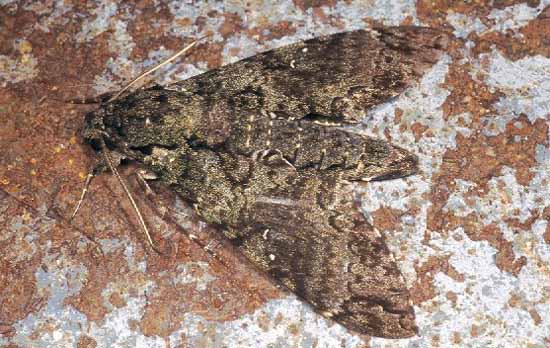
Cocytius duponchel from Rancho Grande,
H. Pittier National Park, Venezuela
courtesy of Paolo Mazzei.
This site has been created by
Bill Oehlke.
Comments, suggestions and/or additional information are welcomed by Bill.
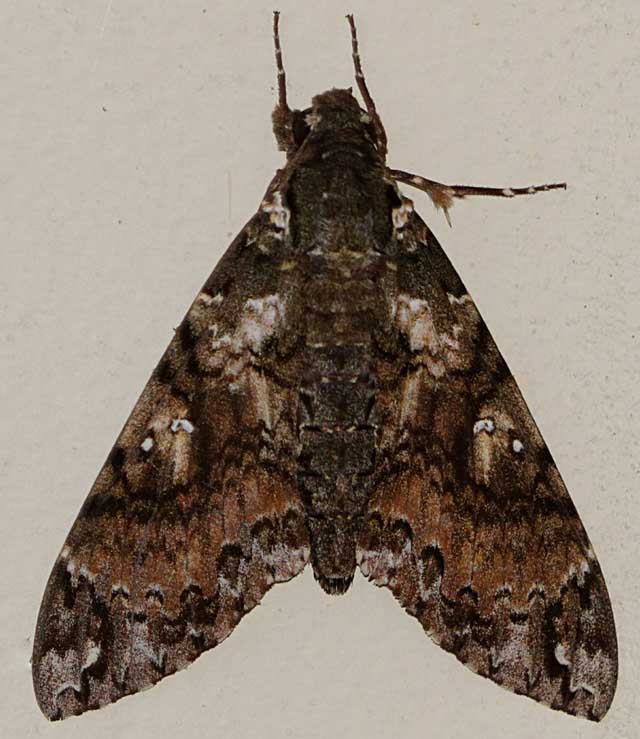
Cocytius duponchel female, Massaranduba, Santa Catarina, Brazil,
courtesy of Joao Amarildo Ranguetti, id by Jean Haxaire.
TAXONOMY:
Family: Sphingidae, Latreille, 1802
Subfamily: Sphinginae, Latreille, [1802]
Tribe: Sphingini, Latreille, 1802
Genus: Cocytius ...........
Species: duponchel (Poey, 1832)
|
DISTRIBUTION:
Duponchel's Sphinx, Cocytius duponchel
(Wing span: 4 5/16 - 5 7/8 inches (11 - 15 cm), males much smaller
than females)], flies in tropical and subtropical lowlands in
Cuba,
the specimen type locality; and generally from
southern Brazil: Rio de Janeiro (LC); Minas Gerais; Santa Catarina (JAR); Rio Grande do Sul (LFA); and
Bolivia: Santa Cruz;
Paraguay: San Pedro; Canindeyu;
Argentina: Tucuman; Misiones; Salta; north to
Venezuela: Amazonas, Apure, Aragua, Bolivar, Cojedes, Falcon,
Guarico, Tachira, Yaracuy;
Suriname: Sipaliwini District: Stoelmanveiland;
French Guiana: Kaw;
probably ?? Guyana ??;
Colombia: Cauca: Parque Nacional Natural Gorgona (HCM); Meta: Villavicencio, 500m (GN); and
Ecuador: Yasuni; Napo (HM); Pichincha (HM)
Mexico;
Belize; Corozol, Cayo, Orange Walk, Stann Creek, Toledo;
Guatemala: Izabal (JM);
Honduras;
Nicaragua: Granada, Chontales, Zelaya,
Rio San Juan;
Costa Rica: Puntarenas, Guanacaste, Alajuela,
Lemon, Heredia, Carthage, San Jose; and the West Indies. It is rare in Florida and Texas.
Jean Haxaire confirms them in Dominican Republic: La Vega.
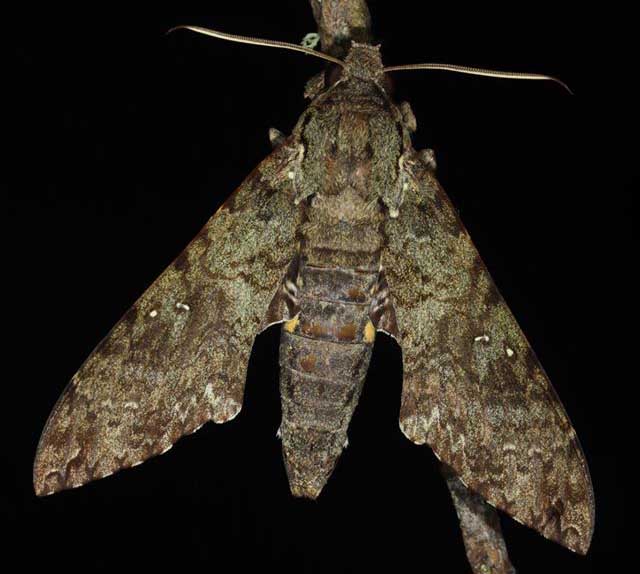
Cocytius duponchel, La Vega, Dominican Republic, courtesy of Jean Haxaire.
CATE: "Forewing upperside with black discal dashes between veins M3 and CuA2 not prominent; discal spot transverse, kidney-shaped, dirty white.
Hindwing upperside with translucent patch posterior to vein M1 shorter than the black marginal band is broad at vein M1."
The upperside of the forewing is dark gray with a blue tint. The yellow patch in the hindwing is deeply divided, and
the transparent area, ending sharply at the black margin, is smaller than that of antaeus. The male has very large
claspers. This picture was taken on September 6, 2002 - 9:32 PM in Yasuni, Ecuador, by Steve Graser.
Robert Lehman confirms them in Honduras.
| 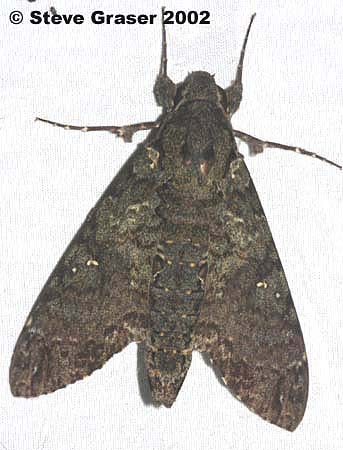 |
They are also taken in Bolivia: Santa Cruz: Florida, Mataral;
Ichilo, Buena Vista; La Víbora; Beni: José Ballivián, Espíritu;
Río Andacuma; La Paz: Murillo, Zongo Cuticucho;
La Paz: La Paz, 11000'; Larecaja, San Agustín, Mapiri, 3500';
Murillo, Río Zongo, 750m; Santa Cruz: Ichilo, Buena Vista, 750m; and in
Argentina: Tucuman.
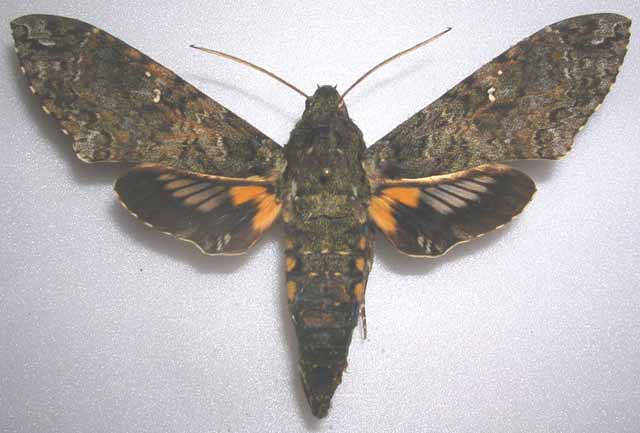
Cocytius duponchel, Brasil, Poté, Minas Gerais, November 11,
2004,
courtesy of Frederik Goussey, possibly Amphonyx rivularis.
This species was originally described as Amphonyx duponchel, but was reclassified as a Cocytius species, and
probably will be listed as Cocytius duponchel for some time.
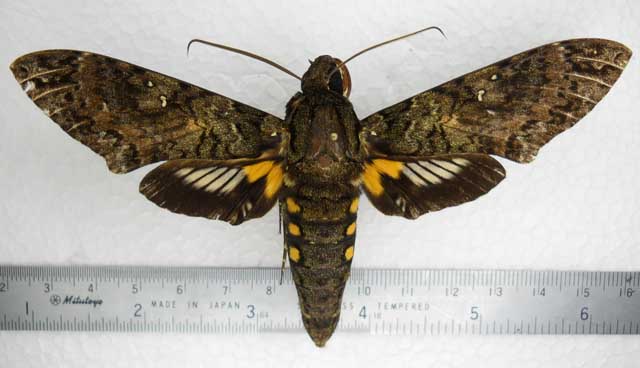
Cocytius duponchel, Parque Nacional Natural Gorgona, Cauca, Colombia,
140mm, May 31, 2011, courtesy of Humberto Calero Mejia,
Evaluación del estado actual de los objetos de conservación faunísticos en Isla Gorgona:
una aproximación holística a la valoración ecológica de Parque Nacional Natural Gorgona.
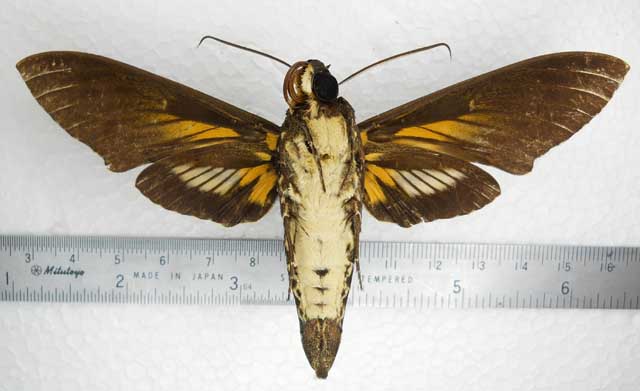
Cocytius duponchel (verso), Parque Nacional Natural Gorgona, Cauca, Colombia,
140mm, May 31, 2011, courtesy of Humberto Calero Mejia,
Evaluación del estado actual de los objetos de conservación faunísticos en Isla Gorgona:
una aproximación holística a la valoración ecológica de Parque Nacional Natural Gorgona.
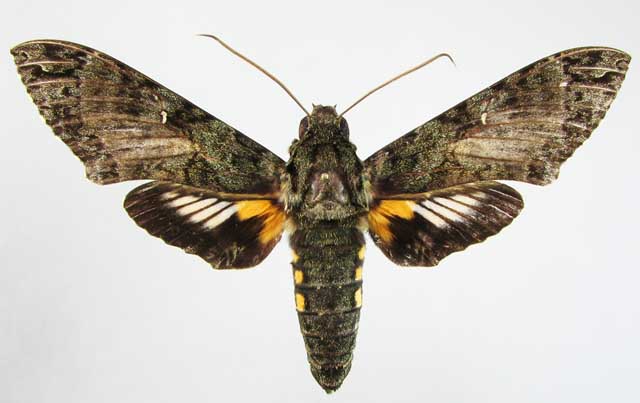
Cocytius duponchel male, Villavicenciom Meta, Colombia,
forewing length = 53mm, January 10, 2012, 500m,
courtesy of Gregory Nielsen, id by Bill Oehlke.
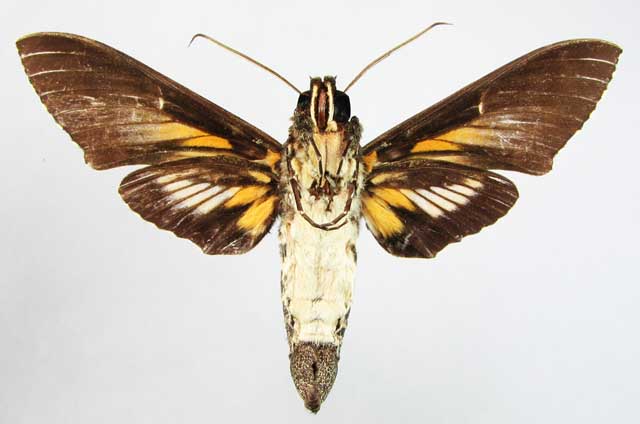
Cocytius duponchel male (verso), Villavicenciom Meta, Colombia,
forewing length = 53mm, January 10, 2012, 500m,
courtesy of Gregory Nielsen, id by Bill Oehlke.
Gregory Nielsen noted the especially large claspers on the male depicted above from Villavicencio, Meta, Colombia.
FLIGHT TIMES:
Cocytius duponchel adults nectar at flowers and brood continuously.
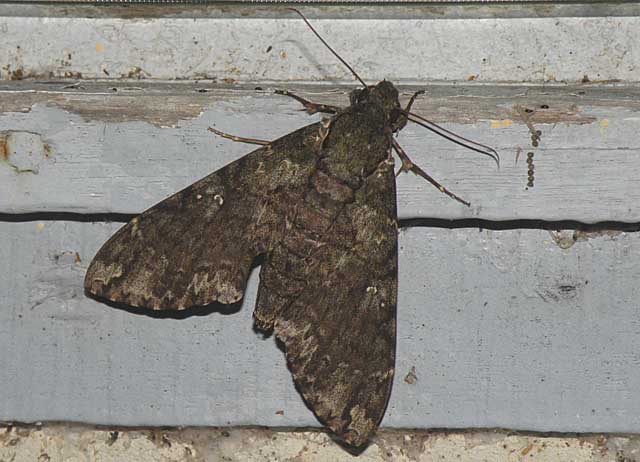
Amphonyx duponchel, Stoelmanseiland, Sipaliwini District, Suriname,
July 22, 2011, courtesy of Johan van't Bosch.
In Bolivia there are records for March-April and June-July-August-September-October-November-December.
There are November records for French Guiana.
Humberto Calero Mejia reports a May 31, 2011, flight in PNN Gorgona, Cauca, Colombia; Gregory Nielsen reports a January flight in Meta, Colombia.
Both males and females come to lights. Andres Urbas reports an April 1, 2011, flight near Kaw, French Guiana.
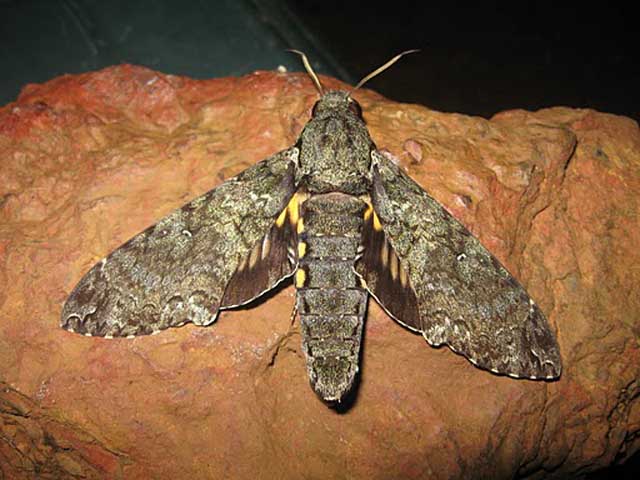
Cocytius duponchel, Camp Caiman, near Kaw, French Guiana,
April 1, 2011, courtesy of Andres Urbas.
ECLOSION:
Pupae probably wiggle to surface from subterranean chambers just prior to eclosion.
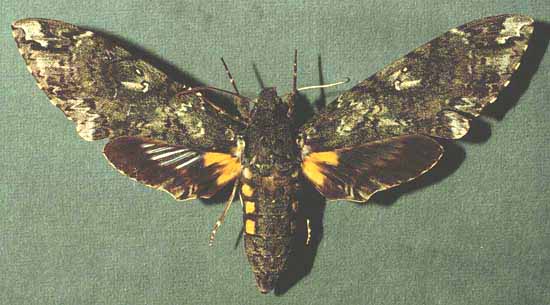
Cocytius duponchel female from Costa Rica, courtesy of Dan Janzen.
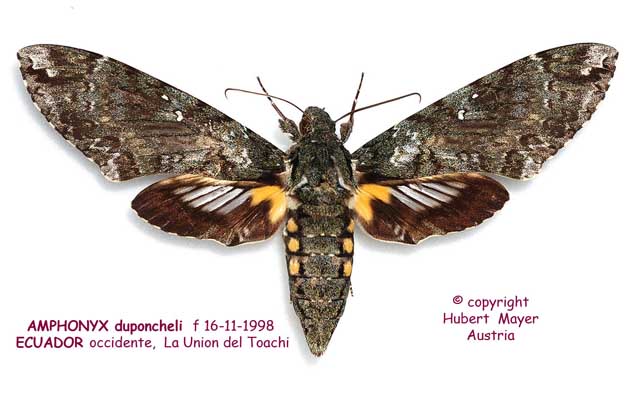
Cocytius duponchel female, La Union del Toachi, Ecuador,
November 16, 1998, courtesy of Hubert Mayer.
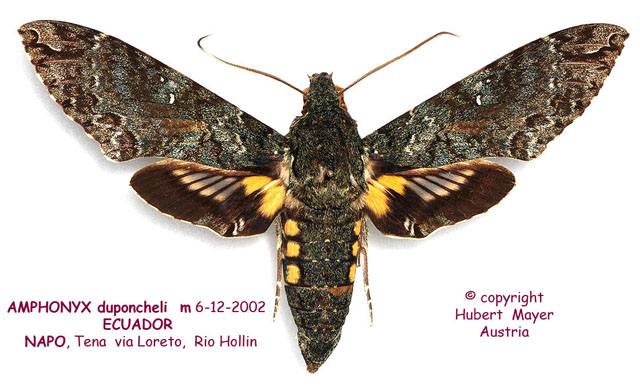
Cocytius duponchel male, Tena, Napo, Ecuador,
December 6, 2002, courtesy of Hubert Mayer.
SCENTING AND MATING:Females call in the males with a pheromone released from a gland at the tip of the
abdomen. The females seem to have much more white on the forewings as compared to the males. The image to the right was taken in
Yasuni, Ecuador, September 7, 2002, at 2:20 AM by Steve Graser. | 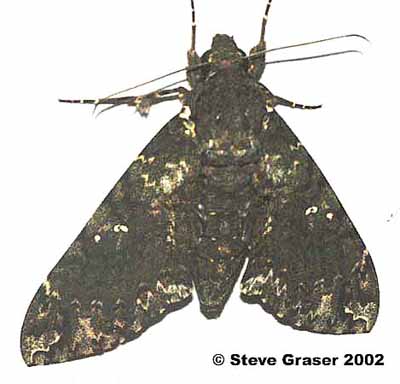
|
EGGS, LARVAE, PUPAE:
Colourful larvae (not hairy, white posterior slash that fades into bluish,
1-2 white posterior costal slashes, maroon line down center of apple green back, 13.2 g as large last instar) feed on Guatteria diospyroides,
Annona purpurea, Annona reticulata, Xylopia frutescens
and Custard apple (Annona glabra) and probably other members of the Annonaceae family.
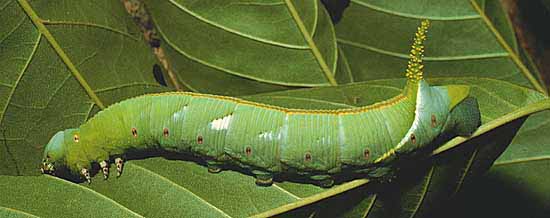
Moths emerge from pupae in as few as 21 days from
pupation. | 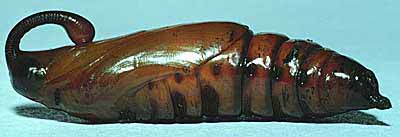 |
Larvae are subject to parasitization from Leschenaultia sp. 12 of the Tachinidae family.
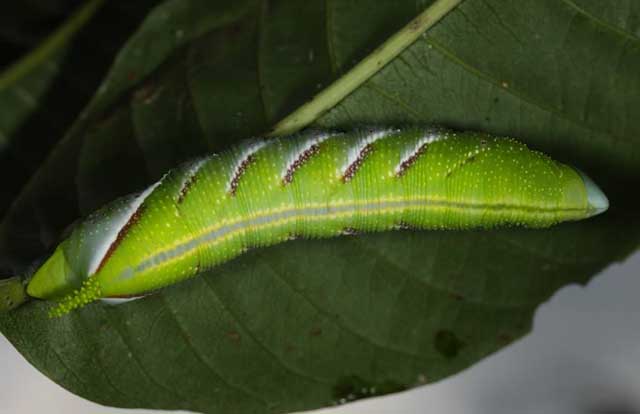
Cocytius duponchel, La Vega, Dominican Republic, courtesy of Jean Haxaire.
The following images from Rio Grande do Sul, Brazil, have been identified by Jean Haxaire as Cocytius duponchel.
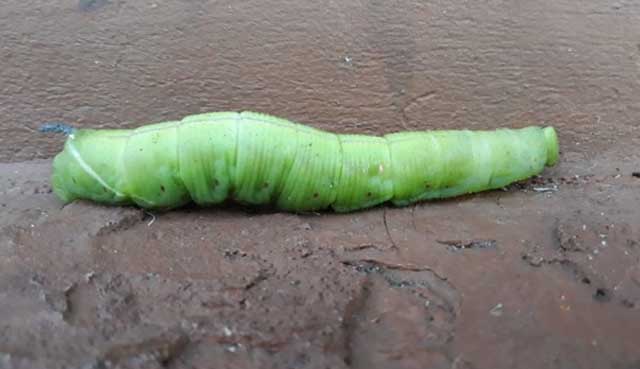
Cocytius duponchel final instar, Horizontia, Rio Grande do Sul, Brazil,
June 11, 2019, courtesy of Geovana Alberti, via Luis F. Alberti,
identification suggested by Jean Haxaire.
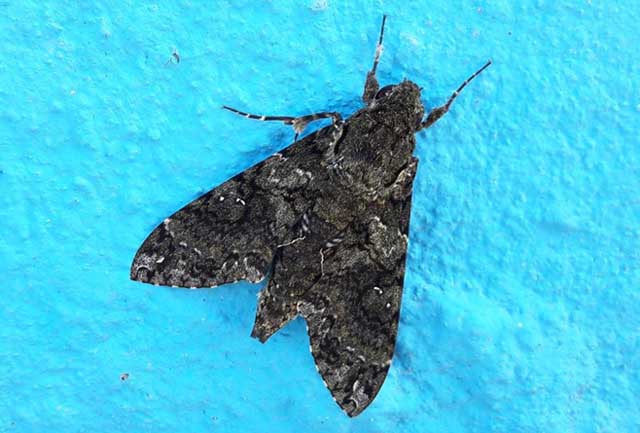
Cocytius duponchel, Rio de Janeiro, Rio de Janeiro, Brazil,
August 16, 2019, courtesy of Laiz Carvalho, via Luis F. Alberti,
identification by Jean Haxaire.
Please send sightings/images to Bill. I will do my best to respond to requests for identification help.
Return to U. S.A. Table
Return to Sphingidae Index
Return to Sphingini Tribe
Goto to Indices by Nation
Use your browser "Back" button to return to the previous page.
This site has been created by Bill Oehlke.
Comments, suggestions and/or additional information are welcomed by Bill.
Enjoy one of nature's wonderments: Live Saturniidae (Giant Silkmoth) cocoons.
 | 
Show appreciation for this site by clicking on flashing butterfly to the left.
The link will take you to a page with links to many insect sites. |
This website has been created and is maintained by Bill Oehlke without government or institutional financial assistance. All expenses, ie., text reference
support material, webspace rental from Bizland, computer repairs/replacements, backups systems, software for image adjustments (Adobe Photoshop; L-View),
ftp software, anti-virus protection, scanner, etc. are my own.
I very much appreciate all the many images that have been sent to me, or of which I have been granted permission to copy and post from other websites.
All images on this site remain the property of respective photographers.
If you would like to contribute to the maintenance of this website by sending a contribution to
Bill Oehlke
Box 476
155 Peardon Road
Montague, Prince Edward Island, C0A1R0
Canada
Your donation would be much appreciated and would be used for
1) paying for webspace rental;
2) paying for computer maintenance and software upgrades;
3) purchases of additional text reference material (journals and books) in an effort to stay current with new species;
4) helping to pay my daughter's tuition (completed spring 2013).
I also hope to expand the North American Catocala site as well as the Sphingidae of the Americas site, to worldwide sites, and that
will require additional funds for reference materials, etc. Both of those site are linked from your WLSS homepage.
If you are mailing a check from USA, please use $0.85 postage ($1.25 is 2015 rate, check first with post office as rates seem to increase annually).
Donations can also be made through Paypal via the button below.





















